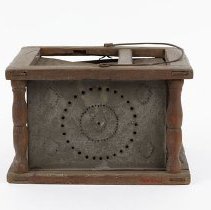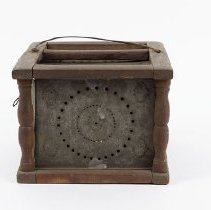
Art & Artifacts Record
Images





Metadata
Object Name |
Warmer, Foot |
Collection |
Artifact collection |
Object ID |
M1984.201a,b |
Year Range from |
1800 |
Year Range to |
1900 |
Dimension Details |
2 1/4" H x 5" W x 14 3/4" D |
Description |
Punched tin foot warmer with circular pattern on all four sides, tin box encased in wooden frame with metal handle on top; inside tin box is a small pan with handle used for storing hot coals. |
Place Names |
Brooklyn (New York, N.Y.) Flatbush (New York, N.Y.) |
Subject Headings |
Church services |
Personal and Corporate Names |
Flatbush Dutch Reformed Church (Flatbush, New York, N.Y.) |
Curatorial Notes |
According to family tradition, members of Brooklyn's Lott family once used this small portable foot warmer to fight the cold during church services at the Flatbush Reformed Church (still standing today at the corner of Flatbush Avenue and Church Avenue in Brooklyn). Sometimes also called "foot stoves," accessories like this one-with its wooden frame, decorative turned posts, and perforated tinned sheet iron walls-were particularly popular in the United States throughout the nineteenth century. Although not particularly expensive when it was purchased, the extra coals needed to fill the foot warmer likely made it a luxury not all were willing to pay for. The Flatbush Reformed Church is one of the oldest in Brooklyn, their first wooden church built in 1654 on the order of New Amsterdam Director-General, Peter Stuyvesant. In 1699, a stone church replaced the aging wooden structure. Members of the Lott family likely carried this foot warmer into the third Flatbush Reformed Church, designed by architect Thomas Fardon and built between 1793 and 1798. In 1966, the New York City Landmarks Fardon's brick building, with its towering spire, was designated a New York City landmark. |
